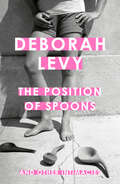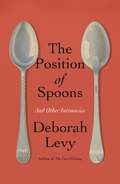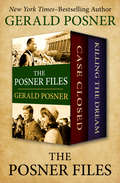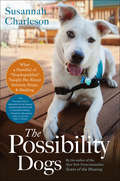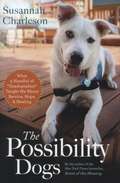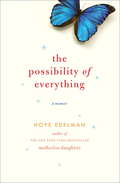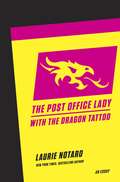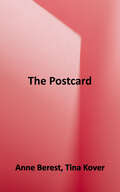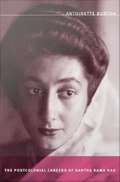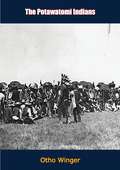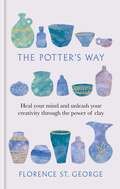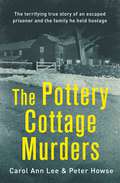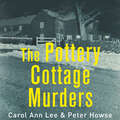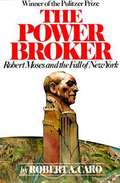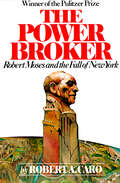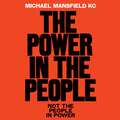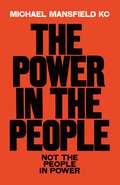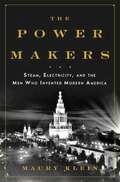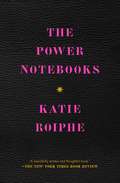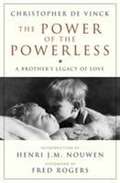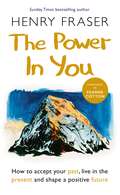- Table View
- List View
The Position of Spoons: And Other Intimacies
by Deborah LevyFrom twice Booker-shortlisted author Deborah Levy, a feast of observations about everything from the particular beauty of lemons on a table, to the muses that have shaped her life, to the streets of Paris.In The Position of Spoons, Deborah Levy invites us into the interiors of her world, sharing her most intimate thoughts and experiences, as she traces and measures her life against the backdrop of the literary and artistic muses that have shaped her.From Marguerite Duras to Colette and Ballard, and from Lee Miller to Francesca Woodman and Paula Rego, we can relish here the richness of their work and, in turn, the richness of the author&’s own.Each page draws upon Levy&’s life in exalting ways, encapsulating the wonderful precision and astonishing depth of her writing, as she seamlessly shifts between and mediates on questions of morality, language, suburbia, gender, consumerism, and the poetics of everyday living. From the child born in South Africa, to her teenage years in Britain, to her travels across the world as a young woman, each page is a beautiful, tender composition of the questioning self: a portrait of Deborah Levy&’s writing life and intellectual vitality in all its dimensions.
The Position of Spoons: And Other Intimacies
by Deborah LevyA feast of observations about everything from the particular beauty of lemons on a table, to the allure of Colette, to the streets of Paris, by the inimitable Deborah Levy.Deborah Levy’s vital literary voice speaks about many things.On footwear: “It has always been very clear to me that people who wear shoes without socks are destined to become my friends and lovers.” On public parks: “A civic garden square gentles the pace of the city that surrounds it, holding a thought before it scrambles.” On Elizabeth Hardwick: “She understands what is at stake in literature.” On the conclusion of a marriage: “It doesn’t take an alien to tell us that when love dies we have to find another way of being alive.”Levy shares with us her most tender thoughts as she traces and measures her life against the backdrop of different literary imaginations; each page is a beautiful, questioning composition of the self. The Position of Spoons is full of wisdom and astonishments and brings us into intimate conversation with one of our most insightful, intellectually curious writers.
The Posner Files: Case Closed and Killing the Dream
by Gerald PosnerDefinitive accounts of JFK&’s and Martin Luther King&’s assassinations by a Pulitzer Prize finalist and New York Times–bestselling author. Case Closed: A Pulitzer Prize finalist and New York Times bestseller, Case Closed is a vivid and straightforward account that stands as one of the most authoritative books on the assassination of John F. Kennedy. Drawing from official sources and dozens of interviews, filled with powerful historical detail, and including an updated comment for the fiftieth anniversary, Posner&’s &“utterly convincing&” book lays to rest all of the convoluted conspiracy theories—concerning the mafia, a second shooter, and the CIA—that have obscured what really happened in Dealey Plaza on November 22, 1963 (Chicago Tribune). &“By far the most lucid and compelling account . . . of what probably did happen in Dallas—and what almost certainly did not.&” —The New York Times Book Review Killing the Dream: On April 4, 1968, Martin Luther King Jr., was killed in Memphis, Tennessee, by a single assassin&’s bullet. James Earl Ray was seen fleeing from a rooming house that overlooked the hotel balcony where King was shot. An international manhunt ended two months later with Ray&’s capture. Though Ray initially pled guilty, he quickly recanted and for the rest of his life insisted he was an unwitting pawn in a grand conspiracy. In Killing the Dream, expert investigative reporter Gerald Posner cuts through phony witnesses, false claims, and a web of misinformation to put Ray&’s conspiracy theory to rest and disclose what really happened the day King was murdered. &“A superb book: a model of investigation, meticulous in its discovery and presentation of evidence, unbiased in its exploration of every claim. And it is a wonderfully readable book, as gripping as a first-class detective story.&” —The New York Times
The Possibility Dogs: What a Handful of "Unadoptables" Taught Me About Service, Hope, & Healing
by Susannah Charleson&“A moving page-turner of a memoir from an accomplished trainer who shifts from the work of search and rescue to that of psychiatric service dogs.&”—The Boston Globe After a grisly search-and-rescue operation led to troubling consequences for author Susannah Charleson, she found that her relationship with Puzzle, her search dog, made a surprising contribution to her own healing. Inspired by that experience, Charleson learned to identify abandoned dogs with service potential, plucking them from shelters and training them to work with disabled human partners, to whom the dogs bring assistance, comfort, and hope. Similar to her New York Times bestselling first book, Scent of the Missing, Charleson&’s The Possibility Dogs goes beyond the science that explains working canines to tell the stories of the dogs themselves. Like Merlin, a black Lab puppy who had been thrown away in a garbage bag and now stabilizes his partner&’s panic attacks. And service dog Jake Piper, a formerly starving pit bull mix who went from abandoned to irreplaceable. This heartwarming combination of memoir and research is sure to both inform and inspire. &“For everyone who is interested in the human animal bond, this book is essential reading. Learn how service dogs can provide emotional support for people who are in great need.&”—Temple Grandin, author of Animals Make us Human and Animals in Translation &“You don&’t have to be an animal lover to be moved by this beautifully written and impassioned account of the author&’s work rescuing dogs from shelters and training them to be service animals . . . This is the rare book that can change minds about the reality of animals&’ emotional lives.&”—Publishers Weekly (starred review)
The Possibility Dogs: What a Handful of Unadoptables Taught Me About Service, Hope, and Healing
by Susannah CharlesonThe Possibility Dogs: What a Handful of "Unadoptables" Taught Me about Service, Hope, and Healing is an "inspiring story that shows how dogs can be rescued, and can rescue in return. With her critically acclaimed, bestselling first book, Scent of the Missing, Susannah Charleson was widely praised for her unique insight into the kinship between humans and dogs, as revealed through her work in canine search and rescue alongside her partner, golden retriever Puzzle. Now, in The Possibility Dogs, Charleson journeys into the world of psychiatric service, where dogs aid humans with disabilities that may be unseen but are no less felt. This work had a profound effect on Charleson, perhaps because, for her, this journey began as a personal one: Charleson herself struggled with posttraumatic stress disorder for months after a particularly grisly search. Collaboration with her search dog partner made the surprising difference to her own healing. Inspired by that experience, Charleson learns to identify abandoned dogs with service potential, often plucking them from shelters at the last minute, and to train them for work beside hurting partners, to whom these second-chance dogs bring intelligence, comfort, and hope. Along the way she comes to see canine potential everywhere, often where she least expects it - from Merlin the chocolate lab puppy with the broken tail once cast away in a garbage bag, who now stabilizes his partner's panic attacks; to Ollie, the blind and deaf terrier, rescued moments before it was too late, who now soothes anxious children; to Jake Piper, the starving pit bull terrier mix with the wayward ears who is transformed into a working service dog and, who, for Charleson, goes from abandoned to irreplaceable."
The Possibility of Everything: A Memoir
by Hope EdelmanFrom the bestselling author of "Motherless Daughters" comes the real-life story of one woman's search for a cure to her family's escalating troubles, and the leap of faith that took her on a journey to an exotic place and a new state of mind.
The Post Office Lady with the Dragon Tattoo: An Essay
by Laurie Notaro"I had been dreading this day for more than a year." Everyone's favorite Idiot Girl, Laurie Notaro, is very close to wearing out her welcome in her hometown of Eugene, Oregon. Just a year ago, she was eighty-sixed from the local satellite post office for buying too many two-cent stamps ("The post office lady looked at me like I had just asked her if she wanted to buy my sex tape"). Now Notaro, needing to send an important care package to her nephew, returns to the scene of the non-crime--which is located inside a drugstore that is stocked with everything from Hello Kitty trinkets to fake poo to "the largest collection of aging candy on the West Coast." Will the post office lady who banned her the first time around kick her to the curb, or will Laurie use her Idiot Girl wiles to work her way back into the Mean Lady's good graces? In this hilarious short story, New York Times bestselling author Laurie Notaro's signature pluck and irresistible candor are on full display and will have you laughing out loud.
The Postcard
by Anne BerestWinner of the Choix Goncourt Prize, Anne Berest’s The Postcard is a vivid portrait of twentieth-century Parisian intellectual and artistic life, an enthralling investigation into family secrets, and a poignant tale of a Jewish family devastated by the Holocaust and partly restored through the power of storytelling. January, 2003. <P><P>Together with the usual holiday cards, an anonymous postcard is delivered to the Berest family home. On the front, a photo of the Opéra Garnier in Paris. On the back, the names of Anne Berest’s maternal great-grandparents, Ephraïm and Emma, and their children, Noémie and Jacques—all killed at Auschwitz. <P><P>Fifteen years after the postcard is delivered, Anne, the heroine of this novel, is moved to discover who sent it and why. Aided by her chain-smoking mother, family members, friends, associates, a private detective, a graphologist, and many others, she embarks on a journey to discover the fate of the Rabinovitch family: their flight from Russia following the revolution, their journey to Latvia, Palestine, and Paris. What emerges is a moving saga that shatters long-held certainties about Anne’s family, her country, and herself.
The Postcolonial Careers of Santha Rama Rau
by Antoinette BurtonSantha Rama Rau was one of the best known South Asian writers in postwar America. Born into India's elite in 1923, Rama Rau has lived in the United States since the 1940s. Although she is no longer well known, she was for several decades a popular expert on India. She provided an insider's view of Indian cultures, traditions, and history to an American public increasingly aware of the expanded role of the United States on the world stage. Between 1945 and 1970, Rama Rau published half a dozen books, including travelogues, novels, a memoir, and a Time-Life cookbook; she was a regular contributor to periodicals such as the New Yorker, the New York Times, McCall's, and Reader's Digest. Drawing on archival research and interviews with Rama Rau, historian Antoinette Burton opens Rama Rau's career into an examination of orientalism in the postwar United States, the changing idioms of cosmopolitanism in the postcolonial era, and the afterlife of British colonialism in the American public sphere. Burton describes how Rama Rau's career was shaped by gendered perceptions of India and "the East" as well as by the shifting relationships between the United States, India, Pakistan, and Great Britain during the Cold War. Exploring how Rama Rau positioned herself as an expert on both India and the British empire, Burton analyzes the correspondence between Rama Rau and her Time-Life editors over the contents of her book The Cooking of India (1969), and Rama Rau's theatrical adaptation of E. M. Forster's A Passage to India, which played on Broadway in 1961 and was the basis for David Lean's 1985 film. Burton assesses the critical reception of Rama Rau's play as well as her correspondence with Forster and Lean.
The Potawatomi Indians: The History, Trails And Chiefs Of The Potawatomi Native American Tribe
by Otho WingerFascinating and detailed history, originally publish in 1939, of the Native American Potawatomi tribe.“The Pot-a-wat-o-mi Indians were a tribe of the great Algonquin race, whose tribes stretched from the Atlantic to the Mississippi and beyond. The original home of the Potawatomi was with or near, the parent tribe in the great lake region of northern Michigan, on the western shores of Lake Huron. From here they were driven west by the powerful Iroquois.In the French and Indian War the Potawatomi, like most of the tribes of the Northwest, took the side of the French. After the war, when the English had placed garrisons here and there, the Potawatomi joined Pontiac in his conspiracy to drive the English from the Indian lands.”—Chapter 1
The Potter's Way: Heal your mind and unleash your creativity through the power of clay
by Florence St. George'Warm, honest and full of inspiring tips, Florence's story shows us that pottery has the power to soothe the heart and heal the mind.' JULIA SAMUEL, author of Grief Works and This Too Shall PassSometimes, the smallest things lead to the biggest changes. When struggling with depression and feeling lost after the birth of her daughter, Florence St. George began experimenting with a lump of clay on her kitchen table. Pot by pot, bowl by bowl, she discovered that as her hands became busier, her mind grew calmer. In just a few years, Florence went from complete beginner to contestant on The Great Pottery Throw Down, learning what clay has to teach along the way: that creativity doesn't have to be expensive, that pottery is the perfect antidote to internet overload and that working with clay can ground you like nothing else.In The Potter's Way, Florence shares her tips on how to get started on your own pottery journey, from hand-building pinch pots to throwing large-scale vessels on the wheel. This captivating book invites us all to slow down, reflect and experience the transformative power of creativity.'I have found nothing outside myself that can truly fill the void, but this book demonstrates that pottery is about as close as it gets.' NICK LOVE, film director and writer
The Potter's Way: Heal your mind and unleash your creativity through the power of clay
by Florence St. George'Warm, honest and full of inspiring tips, Florence's story shows us that pottery has the power to soothe the heart and heal the mind.' JULIA SAMUEL'An honest and redemptive story about the power of fun and creativity - I've always said if it was mandatory to wear a smock once a week and get messy with clay, adults would be happier.' MIRANDA HARTSometimes, the smallest things lead to the biggest changes. When struggling with depression and feeling lost after the birth of her daughter, Florence St. George began experimenting with a lump of clay on her kitchen table. Pot by pot, bowl by bowl, she discovered that as her hands became busier, her mind grew calmer. In just a few years, Florence went from complete beginner to contestant on The Great Pottery Throw Down, learning what clay has to teach along the way: that creativity doesn't have to be expensive, that pottery is the perfect antidote to internet overload and that working with clay can ground you like nothing else.In The Potter's Way, Florence shares her tips on how to get started on your own pottery journey, from hand-building pinch pots to throwing large-scale vessels on the wheel. This captivating book invites us all to slow down, reflect and experience the transformative power of creativity.'I have found nothing outside myself that can truly fill the void, but this book demonstrates that pottery is about as close as it gets.' NICK LOVE'This book is a journey, with a map. Like all maps, it relay's history, from the first point of contact to pivotal moments along the way. I like a map. They help us to find our way.' INDIA HICKS
The Pottery Cottage Murders: The terrifying true story of an escaped prisoner and the family he held hostage
by Carol Ann Lee Peter HowseA psychopathic criminal on the run from prison. A family of five held hostage in their home. A frantic police manhunt across the snowbound Derbyshire moors. Just one survivor.The definitive account of the terrifying 1977 Pottery Cottage murders that shocked Britain. For three days, escaped prisoner Billy Hughes played macabre psychological games with Gill Moran and her family, keeping them in separate rooms of their home while secretly murdering them one by one. On several occasions Hughes ordered Gill and her husband Richard to leave the house for provisions, confident that they would return without betraying him in order to protect their loved ones.Blizzards hampered the desperate police search, but they learned where the dangerous convict was hiding and closed in on the cottage. A high-speed car chase on icy roads ended with a crash and the killer being shot as he swung a newly sharpened axe at his final victim. This was Britain's first instance of police officers committing 'justifiable homicide' against an escapee. The story of these terrible events is told here by Carol Ann Lee and Peter Howse, the former chief inspector who saved Gill Moran's life over forty years ago.Peter's professional role has permitted access to witness statements, crime scene photographs and police reports. Peter Howse and Carol Ann Lee have made use of these, along with fresh interviews with many of those directly involved, to tell a fast-paced and truly shocking story with great insight and empathy.
The Pottery Cottage Murders: The terrifying true story of an escaped prisoner and the family he held hostage
by Carol Ann Lee Peter HowseA psychopathic criminal on the run from prison. A family of five held hostage in their home. A frantic police manhunt across the snowbound Derbyshire moors. Just one survivor.The definitive account of the terrifying 1977 Pottery Cottage murders that shocked Britain. For three days, escaped prisoner Billy Hughes played macabre psychological games with Gill Moran and her family, keeping them in separate rooms of their home while secretly murdering them one by one. On several occasions Hughes ordered Gill and her husband Richard to leave the house for provisions, confident that they would return without betraying him in order to protect their loved ones.Blizzards hampered the desperate police search, but they learned where the dangerous convict was hiding and closed in on the cottage. A high-speed car chase on icy roads ended with a crash and the killer being shot as he swung a newly sharpened axe at his final victim. This was Britain's first instance of police officers committing 'justifiable homicide' against an escapee. The story of these terrible events is told here by Carol Ann Lee and Peter Howse, the former chief inspector who saved Gill Moran's life over forty years ago.Peter's professional role has permitted access to witness statements, crime scene photographs and police reports. Peter Howse and Carol Ann Lee have made use of these, along with fresh interviews with many of those directly involved, to tell a fast-paced and truly shocking story with great insight and empathy.
The Pottery Cottage Murders: The terrifying true story of an escaped prisoner and the family he held hostage
by Carol Ann Lee Peter HowseIncludes an exclusive interview with Peter Howse and Carol Ann LeeA psychopathic criminal on the run from prison. A family of five held hostage in their home. A frantic police manhunt across the snowbound Derbyshire moors. Just one survivor.The definitive account of the terrifying 1977 Pottery Cottage murders that shocked Britain. For three days, escaped prisoner Billy Hughes played macabre psychological games with Gill Moran and her family, keeping them in separate rooms of their home while secretly murdering them one by one. On several occasions Hughes ordered Gill and her husband Richard to leave the house for provisions, confident that they would return without betraying him in order to protect their loved ones.Blizzards hampered the desperate police search, but they learned where the dangerous convict was hiding and closed in on the cottage. A high-speed car chase on icy roads ended with a crash and the killer being shot as he swung a newly sharpened axe at his final victim. This was Britain's first instance of police officers committing 'justifiable homicide' against an escapee. The story of these terrible events is told here by Carol Ann Lee and Peter Howse, the former chief inspector who saved Gill Moran's life over forty years ago.Peter's professional role has permitted access to witness statements, crime scene photographs and police reports. Peter Howse and Carol Ann Lee have made use of these, along with fresh interviews with many of those directly involved, to tell a fast-paced and truly shocking story with great insight and empathy.
The Poverty of Philosophy
by Karl MarxThis is an answer to "The Philosophy of Poverty" by M. Proudhon.
The Power Broker: Robert Moses and the Fall of New York
by Robert A. CaroThe Power Broker tells the hidden story behind the shaping (and mis-shaping) of twentieth-century New York (city and state) and makes public what few have known: that Robert Moses was, for almost half a century, the single most powerful man of our time in New York, the shaper not only of the city's politics but of its physical structure and the problems of urban decline that plague us today. In revealing how Moses did it--how he developed his public authorities into a political machine that was virtually a fourth branch of government, one that could bring to their knees Governors and Mayors (from La Guardia to Lindsay) by mobilizing banks, contractors, labor unions, insurance firms, even the press and the Church, into an irresistible economic force--Robert Caro reveals how power works in all the cities of the United States. Moses built an empire and lived like an emperor. He personally conceived and completed public works costing 27 billion dollars--the greatest builder America (and probably the world) has ever known. Without ever having been elected to office, he dominated the men who were--even his most bitter enemy, Franklin D. Roosevelt, could not control him--until he finally encountered, in Nelson Rockefeller, the only man whose power (and ruthlessness in wielding it) equalled his own.<P><P> Pulitzer Prize Winner
The Power Broker: Robert Moses and the Fall of New York
by Robert A. CaroPULITZER PRIZE WINNER • A modern American classic, this huge and galvanizing biography of Robert Moses reveals not only the saga of one man&’s incredible accumulation of power but the story of his shaping (and mis-shaping) of twentieth-century New York. One of the Modern Library&’s hundred greatest books of the twentieth century, Robert Caro's monumental book makes public what few outsiders knew: that Robert Moses was the single most powerful man of his time in the City and in the State of New York. And in telling the Moses story, Caro both opens up to an unprecedented degree the way in which politics really happens—the way things really get done in America's City Halls and Statehouses—and brings to light a bonanza of vital information about such national figures as Alfred E. Smith and Franklin D. Roosevelt (and the genesis of their blood feud), about Fiorello La Guardia, John V. Lindsay and Nelson Rockefeller. But The Power Broker is first and foremost a brilliant multidimensional portrait of a man—an extraordinary man who, denied power within the normal framework of the democratic process, stepped outside that framework to grasp power sufficient to shape a great city and to hold sway over the very texture of millions of lives. We see how Moses began: the handsome, intellectual young heir to the world of Our Crowd, an idealist. How, rebuffed by the entrenched political establishment, he fought for the power to accomplish his ideals. How he first created a miraculous flowering of parks and parkways, playlands and beaches—and then ultimately brought down on the city the smog-choked aridity of our urban landscape, the endless miles of (never sufficient) highway, the hopeless sprawl of Long Island, the massive failures of public housing, and countless other barriers to humane living. How, inevitably, the accumulation of power became an end in itself. Moses built an empire and lived like an emperor. He was held in fear—his dossiers could disgorge the dark secret of anyone who opposed him. He was, he claimed, above politics, above deals; and through decade after decade, the newspapers and the public believed. Meanwhile, he was developing his public authorities into a fourth branch of government known as "Triborough"—a government whose records were closed to the public, whose policies and plans were decided not by voters or elected officials but solely by Moses—an immense economic force directing pressure on labor unions, on banks, on all the city's political and economic institutions, and on the press, and on the Church. He doled out millions of dollars' worth of legal fees, insurance commissions, lucrative contracts on the basis of who could best pay him back in the only coin he coveted: power. He dominated the politics and politicians of his time—without ever having been elected to any office. He was, in essence, above our democratic system. Robert Moses held power in the state for 44 years, through the governorships of Smith, Roosevelt, Lehman, Dewey, Harriman and Rockefeller, and in the city for 34 years, through the mayoralties of La Guardia, O'Dwyer, Impellitteri, Wagner and Lindsay, He personally conceived and carried through public works costing 27 billion dollars—he was undoubtedly America's greatest builder. This is how he built and dominated New York—before, finally, he was stripped of his reputation (by the press) and his power (by Nelson Rockefeller). But his work, and his will, had been done.
The Power In The People: How We Can Change The World
by Michael Mansfield'I want this book to inspire people, give them a blueprint for fighting their own battles, and challenge the status quo. To see that together, we are always stronger. To understand that those who stand in the way of change cannot do so forever.' Michael Mansfield, KCBarrister Michael Mansfield, KC, has spent his career fighting injustice, persecution and corruption. And be it the Birmingham Six, Bloody Sunday, Stephen Lawrence, the Marchioness, Hillsborough or Grenfell, he has come to learn one thing - that people power is unstoppable.Time and again he has witnessed governments, police forces, legal institutions and the establishment, try to block change and maintain the status quo in order to protect their interests. But almost every time he has seen that passion, perseverance, collectivity and courage create a powerful momentum which is increasingly difficult to stop.In this short but powerful book, the veteran barrister draws upon his 50 years of fighting for justice and revisits his most important cases and clients, proving without doubt that when people get together they can make lasting and positive change.The power is in the people - not the people in power.(p) 2023 Octopus Publishing Group
The Power In The People: How We Can Change The World
by Michael Mansfield'A lifetime spend fighting the powers that be and turning personal pain into collective power. Take care of this book because you are holding our history in your hands.' - LOWKEY'Michael Mansfield is the greatest civil liberties lawyer this country has ever produced' - Baroness HELENA KENNEDY of the Shaws KC'Michael Mansfield has given power to the voiceless, the innocents ... For this, he too is a hero' - JOHN PILGER'Michael Mansfield combines rare humanity with a brilliant understanding of the law' - JON SNOW'A book of great importance ... Mr Mansfield's thoughtful reflections demand our attention' - KEN LOACH'An impressive and inspiring read' - DUNCAN CAMPBELL 'I want this book to inspire people, give them a blueprint for fighting their own battles, and challenge the status quo. To see that together, we are always stronger. To understand that those who stand in the way of change cannot do so forever.' Michael Mansfield, KCBarrister Michael Mansfield, KC, has spent his career fighting injustice, persecution and corruption. And be it the Birmingham Six, Bloody Sunday, Stephen Lawrence, the Marchioness, Hillsborough or Grenfell, he has come to learn one thing - that people power is unstoppable.Time and again he has witnessed governments, police forces, legal institutions and the establishment, try to block change and maintain the status quo in order to protect their interests. But almost every time he has seen that passion, perseverance, collectivity and courage create a powerful momentum which is increasingly difficult to stop.In this short but powerful book, the veteran barrister draws upon his 50 years of fighting for justice and revisits his most important cases and clients, proving without doubt that when people get together they can make lasting and positive change.The power is in the people - not the people in power.
The Power In The People: How We Can Change The World
by Michael Mansfield'A lifetime spend fighting the powers that be and turning personal pain into collective power. Take care of this book because you are holding our history in your hands.' - LOWKEY'Michael Mansfield is the greatest civil liberties lawyer this country has ever produced' - Baroness HELENA KENNEDY of the Shaws KC'Michael Mansfield has given power to the voiceless, the innocents ... For this, he too is a hero' - JOHN PILGER'Michael Mansfield combines rare humanity with a brilliant understanding of the law' - JON SNOW'A book of great importance ... Mr Mansfield's thoughtful reflections demand our attention' - KEN LOACH'An impressive and inspiring read' - DUNCAN CAMPBELL 'I want this book to inspire people, give them a blueprint for fighting their own battles, and challenge the status quo. To see that together, we are always stronger. To understand that those who stand in the way of change cannot do so forever.' Michael Mansfield, KCBarrister Michael Mansfield, KC, has spent his career fighting injustice, persecution and corruption. And be it the Birmingham Six, Bloody Sunday, Stephen Lawrence, the Marchioness, Hillsborough or Grenfell, he has come to learn one thing - that people power is unstoppable.Time and again he has witnessed governments, police forces, legal institutions and the establishment, try to block change and maintain the status quo in order to protect their interests. But almost every time he has seen that passion, perseverance, collectivity and courage create a powerful momentum which is increasingly difficult to stop.In this short but powerful book, the veteran barrister draws upon his 50 years of fighting for justice and revisits his most important cases and clients, proving without doubt that when people get together they can make lasting and positive change.The power is in the people - not the people in power.
The Power Makers: Steam, Electricity, and the Men Who Invented Modern America
by Maury KleinIN 1800 AMERICA WAS AN AGRARIAN NATION, whose wealth came largely from the land and was extracted only with backbreaking toil. A century later, the country was an industrial superpower and the most advanced material society the world had ever seen. The Power Makers is the story of that transformation and of the dynamic, fiercely competitive men who made it happen. The steam engine, the incandescent lamp, the electric motor-inventions such as these replaced muscle power with machine labor, turned darkness to light, and reshaped every aspect of daily life in the span of a few generations. They were the product of an extraordinary cast of characters: dogged inventors like James Watt and Elihu Thomson; charismatic entrepreneurs like George Westinghouse; daring capitalists like Charles Coffin of General Electric and J. P. Morgan. Others include Samuel Insull, onetime assistant to Thomas Edison, who invented the modern utility business and brought power to millions, and Nikola Tesla, the eccentric Serbian immigrant whose revolutionary AC motor came to him in a vision. Striding among them like a colossus is the figure of Edison, who was creative genius and business visionary at once. With consummate skill, Maury Klein recreates their discoveries, their stunning triumphs and frequent failures, and their unceasing, bare-knuckled battles in the marketplace. Their personalities, and their fierce rivalries, leap off the page. The Power Makers is a saga of inspired invention, undaunted persistence, and business competition at its most naked and cutthroat- a dazzling tale of America in its most astonishing decades.
The Power Notebooks
by Katie RoipheKatie Roiphe, culture writer and author of The Morning After, shares a timely blend of memoir, feminist investigation, and exploration of famous female writers&’ lives, in a bold, essential discussion of how strong women experience their power. Told in a series of notebook entries, Roiphe weaves her often fraught personal experiences with divorce, single motherhood, and relationships with insights into the lives and loves of famous writers such as Sylvia Plath and Simone de Beauvoir. She dissects the way she and other ordinary, powerful women have subjugated their own power time and time again, and she probes brilliantly at the tricky, uncomfortable question of why. In these informal musings and notes, Roiphe delves into treacherous, largely untalked about, contradictions of contemporary womanhood, going where few writers dare. The Power Notebooks is Roiphe&’s most vital, thought provoking, and emotionally intimate work yet.
The Power Of The Powerless: A Brother's Legacy Of Love
by Fred Rogers Henri J. M. Nouwen Christopher De VinckChristopher De Vinck's moving account of his life with his brother made a deep impression on the hearts and minds of Americans. Due to a tragedy at birth, Oliver de Vinck was born severely handicapped--blind, mute, crippled, helpless. Despite the doctors' bleak prognosis, his loving parents took him home, where they and their children cared for him. He lived for thirty-three years.
The Power in You: How to Accept your Past, Live in the Present and Shape a Positive Future
by Henry FraserFrom Sunday Times bestselling author...'Henry Fraser is one of the most remarkable people I've ever met' J.K. Rowling'What a story of transformation, inner power and inspiration' Jonny Wilkinson Mouth artist, motivational speaker and author of the inspirational memoir The Little Big Things, Henry Fraser, explores the transformative power of acceptance in this motivational guide.If The Little Big Things was about Henry's past, The Power in You is about his present and his future. And through understanding his daily experience, Henry teaches us all how best we can live. This book is about right now, and it's about tomorrow.It's about recognising progress, it's about accepting our past to become free of it, it's about living in the now to avoid anxiety. It's future focused on the positive.Henry discusses acceptance, how to adapt and deal with our pasts, how to forgive ourselves, and how to forgive others. He will remind us to live in the present and just how empowering that can be, how to work through self-doubt, how to become aware of our progress, and how everything you need in life comes from within you.The power is in you.
